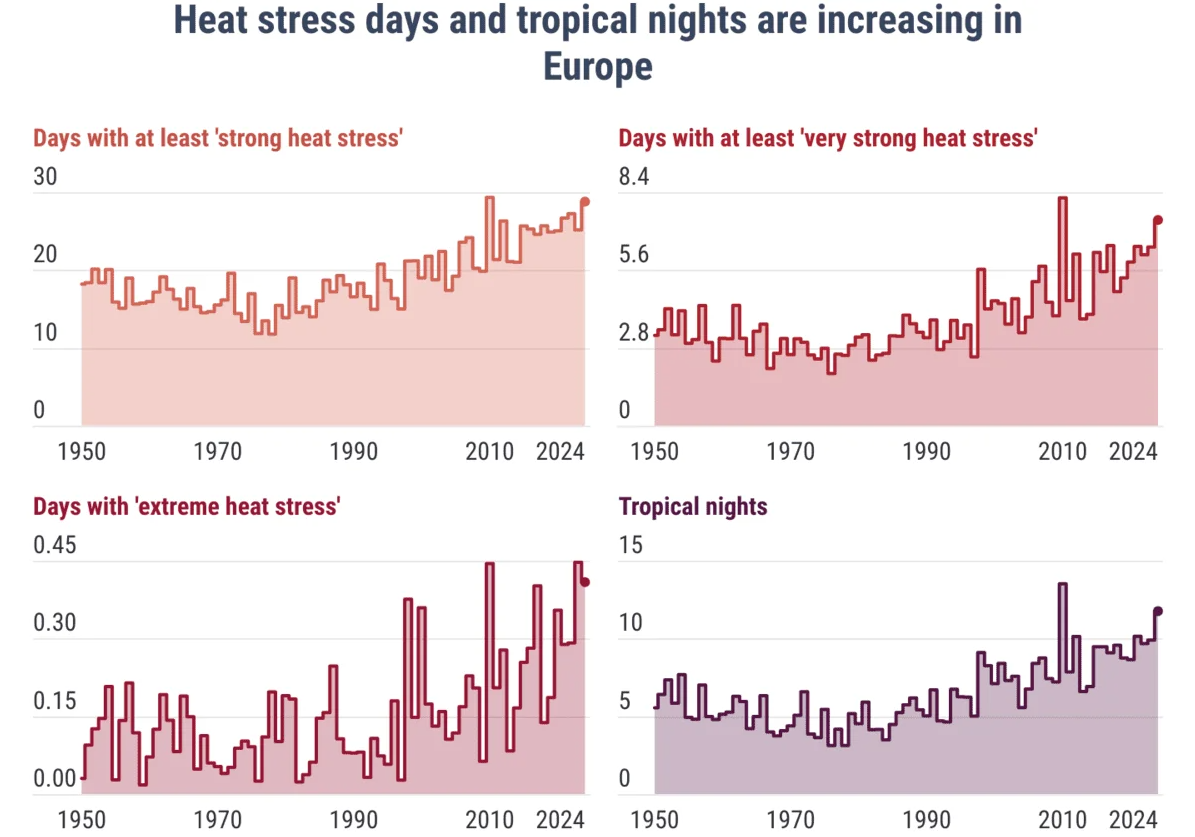Around 60% of Europe experienced more days than average with at least severe heat stress in 2024, defined as a perceived temperature above 100.4°F (38°C). Italian seas ranked among those with the most pronounced thermal anomalies. All the latest data on climate change in Europe is detailed in the 2024 Copernicus report

Europe is warming faster than any other continent. While global temperatures have risen by around +1.3°C since pre-industrial times (1850–1900), the European average has already climbed to +2.4°C. The past year has reinforced this trend. Climate change in Europe set new records in 2024, with widespread extreme weather and what scientists call “severe impacts.”
“Every fraction of a degree matters,” stressed Celeste Saulo, Secretary-General of the World Meteorological Organization (WMO), “as it increases risks to lives, economies, and the planet. Adaptation is not optional.” The mounting evidence of record temperatures and extreme events underscores the urgent need for adaptation and mitigation strategies.
Europe’s 2024 climate in numbers
This alarming picture comes from the 2024 edition of the European State of the Climate Report, a comprehensive assessment by the Copernicus Climate Change Service (C3S) and the WMO. The data confirm that 2024 was the hottest year ever recorded in Europe. The report highlights how climate change in Europe is accelerating, particularly in central, eastern, and southeastern regions, which saw both record temperatures and extreme weather events.
The continent was split in two: the east was hot and dry, while the west was hot and wet. The findings are the result of research by over 100 scientists and include both current impacts and long-term climate trends shaping Europe’s future.
Record heat stress across the continent

Thermal stress is one of the most direct ways people experience climate change in daily life. In 2024:
- High-temperature days became more frequent.
- A growing share of European land was affected.
The number of days classified as “strong,” “very strong,” or “extreme heat stress” was the second highest ever recorded. Around 60% of Europe experienced more days than average with at least “strong heat stress” – defined as a perceived temperature over 100.4°F (38°C), based on temperature, humidity, wind, solar radiation, and surrounding heat.
The consequences are real. In 2023, extreme heat stress was a contributing factor in at least 47,700 deaths across Europe. That number rose to over 61,000 in 2022. Final data for 2024 is not yet available but is expected to follow the same trend.
Average near-surface temperatures (measured at 2 meters) were significantly above normal for 45% of the days in 2024, with 12% of days setting new records. On July 17, 2024, 20% of Europe experienced “very strong heat stress,” the largest area ever recorded in a single day alongside August 7, 2010.
Italy, along with Spain and Greece, ranked among the most affected by heat stress, with a sharp rise in days of extreme heat.
Tropical nights: a growing sign of climate imbalance
Italy also ranks among the top countries for tropical nights, when temperatures stay above 68°F (20°C) throughout the night. More than one-third of Europe (37%) saw abnormally high numbers of tropical nights in 2024. Greece experienced 55 more tropical nights than average.
The area affected is expanding. In the 1970s, about 20% of Europe saw at least one tropical night per year. That figure rose to 34% in the 2010s and 35% so far in the 2020s. Southeastern Europe broke records in 2024 with 23 tropical nights in summer – nearly three times the previous record of 8 in 2012.
Extreme cold is disappearing
At the same time, extreme cold events are declining. In 2024, a record 69% of Europe had fewer than 90 frost days, compared to a historical average of 50%.
Heat and drought in southeastern Europ
Southeastern Europe – including parts of Italy – experienced one of the longest heatwaves ever recorded: 13 consecutive days of intense heat, affecting 55% of the region with anomalies up to 16.6°F (9.2°C) above normal.
This led to widespread heat stress and an unprecedented rise in tropical nights, clearly linked to climate change in Europe. Trends show a shift toward hotter, drier summers, with fewer rainy days and drier soil, increasing the risk of drought and impacting agriculture and water supply.
The drought index, a key metric, showed the driest summer in southeastern Europe in 12 years. More lakes had below-average water levels, and 35% of rivers had “notably” or “exceptionally low” flows.
Rainfall patterns and soil moisture reveal east-west divide
In 2024, Europe saw a stark contrast in rainfall. Western Europe had one of the wettest years in decades, while the east faced severe water deficits. Northern Italy, for example, recorded one of its top ten wettest years ever.
These shifts also altered soil moisture levels, driven by atmospheric circulation changes and broader climate change impacts. Intense rainfall events increased in high-risk zones, while rainfall variability worsened drought in others. These changes are reshaping the hydrological cycle, directly affecting agriculture and water management.
Floods and river levels: the worst since 2013

Europe faced widespread flooding in 2024, the worst year since 2013. Roughly 30% of the continent’s river network exceeded “high” flood thresholds, and 12% reached “severe” levels.
Major events, including storm Boris in central and eastern Europe and flash floods in Valencia, Spain, affected about 413,000 people and caused at least 335 deaths. As global temperatures rise, flood events are expected to grow more frequent and intense, posing increasing risks to infrastructure and communities.
Glaciers and snow: alpine ice loss continues

Glacial melt is one of the clearest signs of climate change. In 2024, glaciers shrank across all regions of Europe, with record ice loss in Scandinavia (1.8 meters) and Svalbard (2.7 meters). The Alps lost an average of 1.2 meters of ice – less than in 2022 (3.6 m) and 2023 (2.4 m), but still dramatic.
Snowfall also declined almost everywhere, except in Scandinavia where trends are slightly upward. Elsewhere, snow days dropped by 5 to 45 compared to historical averages.
Mediterranean Sea: record temperatures and extreme anomalies
Another critical finding from the report is ocean warming. In 2024, the average sea surface temperature (SST) across European seas was 1.3°F (0.7°C) above average, with the Mediterranean Sea reaching 2.2°F (1.2°C) above normal.
The western Mediterranean saw the most extreme anomalies. On August 13, 2024, the SST hit an all-time high of 83.7°F (28.7°C), surpassing the 2023 record of 83°F (28.3°C). The Tyrrhenian, Ionian, Adriatic, and Sicilian seas all recorded new temperature peaks. Anomalies reached up to 7.2°F (4°C) in the Ligurian and northern Adriatic seas and up to 10.8°F (6°C) in the Gulf of Lion.












